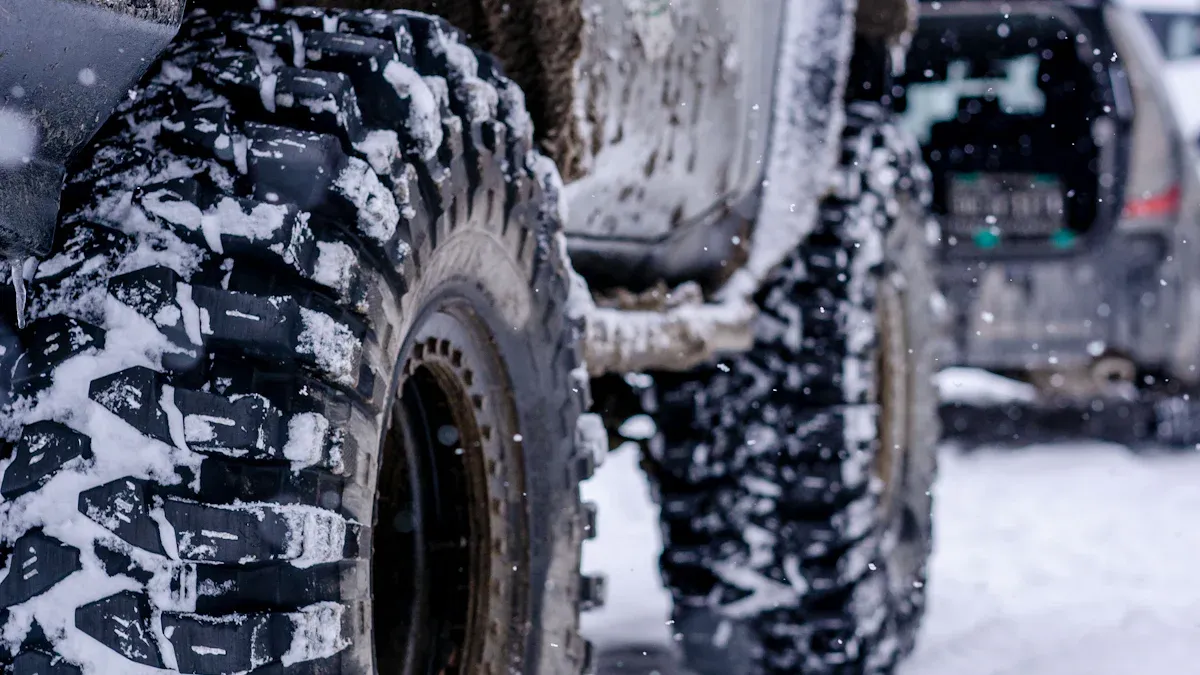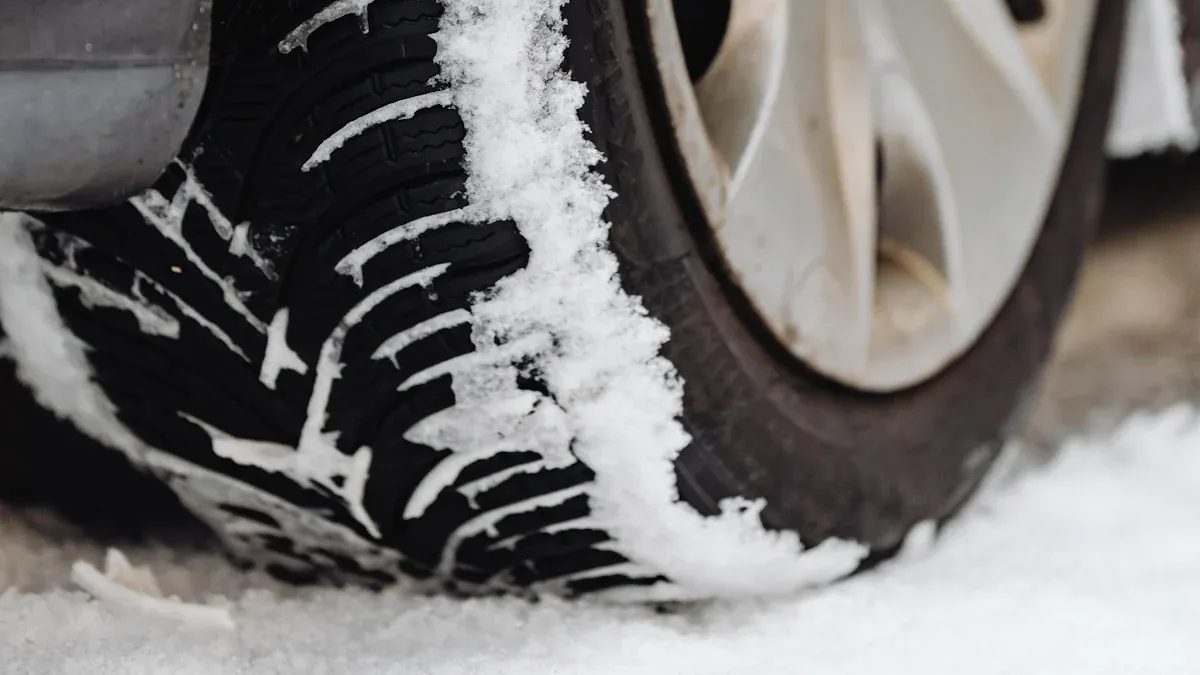
Winter driving can be treacherous without the right tires. Poor traction on snow and ice increases your risk of accidents. Ensuring your snow tire safety is crucial for a smooth and secure ride. Don’t wait until the first snowfall—get your tires ready now!
Key Takeaways
Check your tire tread depth regularly. It should be at least 4/32 of an inch for safe winter driving.
Monitor your tire pressure, especially in cold weather. Low pressure can lead to poor traction and longer stopping distances.
Rotate and balance your tires to ensure even wear. This helps maintain performance and extends tire life.
Why Winter Tires Matter

When winter comes, having the right tires is very important. Winter tires are made to deal with snow and ice. Here’s why they are important:
Benefits of Winter Tires
Enhanced Traction: Winter tires give you better grip on icy and snowy roads. Their special tread patterns help them touch more of the road. This helps you stay in control. Studies show that winter tires can help you stop up to 30% faster than all-season tires. This is important for avoiding accidents.
Better Performance in Cold Weather: The rubber in winter tires stays soft even when it’s freezing. This helps them fit the road better, giving you better traction. In fact, winter tires can stop up to 50% shorter on snowy roads than regular tires. This is very important for your safety in tough winter weather.
Reduced Collision Risk: Using winter tires can lower your chances of having an accident. A study in Canada found that using winter tires led to a 5% drop in winter road injuries. The same study also found a 3% drop in deaths and serious injuries from accidents. With winter tires, you have better control of your vehicle on slippery roads.
Risks of All-Season Tires
While all-season tires may seem easy to use, they can be risky in winter. Here’s a quick comparison:
Aspect | All-Season Tires | Winter Tires |
|---|---|---|
Traction | Limited in icy/snowy conditions | Superior traction on ice and snow |
Cold Resistance | Not made for extreme cold | Made with materials for cold climates |
Stopping Distance | Longer stopping distances in winter | Shorter stopping distances |
Performance in Snow | Varies, some act like summer tires | Optimized for snow-covered roads |
Risk of Losing Control | Higher chance in bad weather | Made to keep control |
All-season tires are not good for cold, icy, or snowy weather. This means higher accident risks. Drivers with all-season tires are more likely to slide and take longer to stop than those with winter tires.
Types of Winter Tires
When choosing winter tires, you have two main types: studded and non-studded tires. Each type has its own pros and cons.
Studded vs. Non-Studded
Studded tires have metal spikes that grip ice. This gives you better control. They work well on icy roads, so many people choose them in places with harsh winters. Here’s a quick comparison:
Performance Aspect | Studded Tires | Non-Studded Tires |
|---|---|---|
Icy Surface Performance | Better grip and control | Moderate grip |
Fuel Efficiency | Uses more fuel (5% more) | More fuel-efficient |
Noise Level | Noisier on dry roads | Quieter on dry roads |
Braking Distance (Wet) | 40 cm shorter from 80 km/h | Slightly longer |
Braking Distance (Dry) | 8 cm shorter from 100 km/h | Similar to studded tires |
You might want studded tires if you live in places like Canada or mountains where winters are tough. They’re also good for people who love winter sports or drive on rough roads.
All-Weather Tires
All-weather tires are another choice. They can handle different conditions, including light snow. Consumer Reports says they can work well in winter and may even do better than winter tires sometimes. But they don’t always perform as well as special winter tires, especially in bad weather.
Experts say that for real winter weather, you should use dedicated winter tires. David Carpenter from Michelin says tough conditions need tires made for freezing temperatures and heavy snow. So, while all-weather tires are flexible, they might not be the safest option when winter hits hard.
Snow Tire Safety: Checking Tire Pressure
It is very important to keep your snow tires inflated for safe winter driving. Low tire pressure can cause bad traction and longer stopping distances. Here’s how to check your tire pressure correctly and see how temperature affects it.
Measuring Tire Pressure
You need a good tire pressure gauge to measure tire pressure. Here’s how to do it:
Choose the Right Time: Check your tire pressure when the tires are cold. Wait at least three hours after driving or check them first thing in the morning.
Remove the Valve Cap: Unscrew the valve cap from the tire you want to check.
Press the Gauge: Firmly press the gauge onto the valve stem. Make sure it fits well to get an accurate reading.
Read the Pressure: Look at the gauge to see the pressure reading. Compare this to the recommended pressure for your vehicle, which is usually between 30 to 35 PSI. Always check the manufacturer’s guidelines for specific recommendations.
Gauge Type | Accuracy | Price | Notes |
|---|---|---|---|
Digital | Very High | ~$12 | Easy to read, especially in dim light |
Stick | Varies | N/A | Less accurate than digital |
Dial | Varies | N/A | Less accurate than digital |
Temperature Effects
Cold weather can change your tire pressure a lot. Here’s what you need to know:
Tire pressure usually drops by about 1 PSI for every 10°F drop in temperature. So, if the temperature drops by 30 degrees, your tire pressure could drop by around 3 PSI.
This happens because the air inside the tires shrinks in the cold, taking up less space. Remember that this effect applies to all types of tires, including snow tires.
Tip: During winter, check your tire pressure at least twice as often. Aim for once a month all year, but in colder months, do it more often. Use a good air gauge for the best accuracy, ideally in the morning or after the car has been parked.
By keeping track of your tire pressure, you can make sure your snow tires work well, helping you stay safe on the road this winter.
Assessing Tread Depth for Snow Tire Safety

Checking your tire tread depth is essential for snow tire safety. A good tread depth helps your tires grip the road better in winter conditions. One simple way to check your tread depth is the penny test.
The Penny Test
Here’s how you can perform the penny test:
Take a penny and place it with Lincoln’s head facing down between two tread ribs on your tire.
If part of Lincoln’s head is covered by the tread, your tires are still in good shape.
If you can see his entire head, your tread is worn down to 2/32 inch or less. It’s time for new tires.
Make sure to repeat this test in various spots on the tire. This helps you check for even wear across the tread.
When to Replace Tires
Knowing when to replace your snow tires is crucial for safety. Here are some guidelines:
Replace your snow tires when they reach approximately 5/32″ of remaining tread depth. This depth is vital for maintaining good traction in snowy conditions.
Look for signs of excessive tread wear. Here’s a quick table to help you identify them:
Sign of Tread Wear | Description |
|---|---|
Tread Depth Check | Use a tread depth gauge or the penny test; if Lincoln’s head is visible, replace the tire. |
Uneven Wear | Check for one side wearing more than the other; this indicates alignment or inflation issues. |
Loss of Traction | If your tires slip on snow or ice despite good tread, the rubber may have hardened, reducing grip. |
Tire Age | Replace winter tires every six years, regardless of tread depth, due to rubber degradation. |
Frequent Air Loss | If you need to inflate your tires regularly, it may indicate internal damage or wear, necessitating replacement. |
By keeping an eye on your tread depth and replacing your tires when necessary, you can ensure your snow tires are ready for winter driving.
Maintenance Tips for Snow Tires
Taking care of your snow tires is very important for safety and performance. Checking them often helps you find problems before they get worse. Here’s what to look for when you check your tires:
Regular Inspections
You should check your snow tires at least once a month. Here are some common problems to look for:
Bulges on the sidewalls
Tread separation
Alignment problems
Also, watch for cuts on the sidewalls or tread. Unusual bulges or bubbles can mean damage. Differences in tread depth or texture may show uneven wear. Regular checks help keep your snow tires safe and make sure they work well when you need them.
Storing Tires
When winter is over, storing your snow tires properly is very important. Here are some tips to keep them in good shape:
Clean and check tires before storing to remove dirt and find damage.
Store tires in a cool, dry place away from sunlight and heat.
Keep tires on rims inflated to the right pressure. You can stack them horizontally or store them vertically if they’re off rims.
Use tire storage bags or covers to protect against dust and moisture.
Check stored tires regularly for signs of damage or wear.
Not storing them correctly can cause problems like moisture damage, deformation, and less traction. These issues can shorten the life of your tires and make them unsafe. By following these tips, you can make sure your snow tires are ready for next winter.
Getting your snow tires ready for winter is very important for safe driving. Here are some main points to remember:
Check tread depth; it should be at least 4/32 of an inch.
Regularly check tire pressure, especially when it’s cold.
Rotate and balance your tires to help them wear evenly.
By doing these things, you can improve your vehicle’s performance and safety this winter. Don’t wait—check your tires now! 🛞❄️
FAQ
How often should I check my snow tire pressure?
Check your snow tire pressure at least once a month, especially during cold weather.
When should I replace my winter tires?
Replace your winter tires when tread depth reaches 5/32 inches or less for optimal safety.
Can I use all-season tires in winter?
All-season tires can struggle in severe winter conditions. It’s safer to use dedicated winter tires for better traction and control.
See Also
The Importance Of Monitoring Tire Tread Depth For Safety
Using A Tire Tread Depth Gauge For Precise Measurements
Understanding Smart Tire Tread Depth Detectors And Their Functionality






